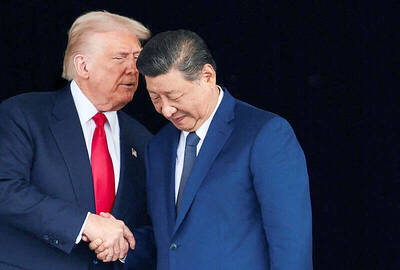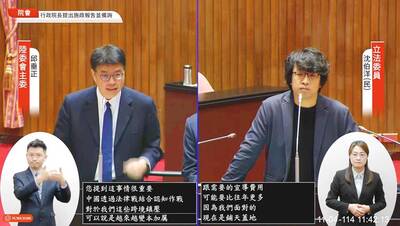Thermal discharge from the Third Nuclear Power Plant is behind the rapid destruction of Kenting National Park’s coral reef, a marine researcher said, warning that the reef’s disappearance would jeopardize the fishing industry and ecosystem.
Allan Chen (陳昭倫), a research fellow with Academia Sinica’s Research Center for Biodiversity, said the plant has accelerated the deterioration of coral by emitting thermal discharge that has driven seawater temperatures 1.5°C to 2°C higher over the past 26 years.
The number of varieties of coral has fallen from between 20 and 30 that existed 26 years ago to three today, Chen said.
Except for the sandy area off western Taiwan, coral can be found all around the nation and off Penghu, where the water temperature has shot up by 1.09°C in recent years. Coral reefs are considered the most important marine ecosystem for the fishing industry, tourism, culture, medicine and coastline protection, Chen said.
Chen’s research shows that Taiwan’s seawater temperature peaked between the 1970s and the 1980s, in line with global trends. In the last six decades, the average temperature of Taiwan’s seawater has risen 0.79°C, slightly higher than the 0.5°C experienced by other tropical sea regions in the world.
Scientists have warned that if global warming continues at its current pace, the world’s coral reefs will completely disintegrate by the end of the century.
Industrial waste, overfishing, pollution, ocean acidification and typhoons all contribute to the destruction and bleaching of coral reefs, the scientist said.
He said the live coral coverage rate in Kenting now was about 70 percent, roughly the same as in 1986, but that the rate could be a misleading indicator because coverage rate does not mean the live corals are fully functioning.
“It’s like tearing down a multifunctional high-rise building like Taipei 101 and replacing the area with one-story houses. You lose most of the original diversity and functionality,” he said.
In related news, a group of rare soft corals has been discovered off the coast of Rueifang Township (瑞芳), Taipei County.
Wang Min-hsian (王銘祥), who made the discovery, described the area as an underwater “crystal palace,” but he said he feared the coral would be destroyed if plans to build a wharf near the site proceed.

CALL FOR SUPPORT: President William Lai called on lawmakers across party lines to ensure the livelihood of Taiwanese and that national security is protected President William Lai (賴清德) yesterday called for bipartisan support for Taiwan’s investment in self-defense capabilities at the christening and launch of two coast guard vessels at CSBC Corp, Taiwan’s (台灣國際造船) shipyard in Kaohsiung. The Taipei (台北) is the fourth and final ship of the Chiayi-class offshore patrol vessels, and the Siraya (西拉雅) is the Coast Guard Administration’s (CGA) first-ever ocean patrol vessel, the government said. The Taipei is the fourth and final ship of the Chiayi-class offshore patrol vessels with a displacement of about 4,000 tonnes, Lai said. This ship class was ordered as a result of former president Tsai Ing-wen’s (蔡英文) 2018

‘SECRETS’: While saying China would not attack during his presidency, Donald Trump declined to say how Washington would respond if Beijing were to take military action US President Donald Trump said that China would not take military action against Taiwan while he is president, as the Chinese leaders “know the consequences.” Trump made the statement during an interview on CBS’ 60 Minutes program that aired on Sunday, a few days after his meeting with Chinese President Xi Jinping (習近平) in South Korea. “He [Xi] has openly said, and his people have openly said at meetings, ‘we would never do anything while President Trump is president,’ because they know the consequences,” Trump said in the interview. However, he repeatedly declined to say exactly how Washington would respond in

WARFARE: All sectors of society should recognize, unite, and collectively resist and condemn Beijing’s cross-border suppression, MAC Minister Chiu Chui-cheng said The number of Taiwanese detained because of legal affairs by Chinese authorities has tripled this year, as Beijing intensified its intimidation and division of Taiwanese by combining lawfare and cognitive warfare, the Mainland Affairs Council (MAC) said yesterday. MAC Minister Chiu Chui-cheng (邱垂正) made the statement in response to questions by Democratic Progressive Party (DPP) Legislator Puma Shen (沈柏洋) about the government’s response to counter Chinese public opinion warfare, lawfare and psychological warfare. Shen said he is also being investigated by China for promoting “Taiwanese independence.” He was referring to a report published on Tuesday last week by China’s state-run Xinhua news agency,

‘ADDITIONAL CONDITION’: Taiwan will work with like-minded countries to protect its right to participate in next year’s meeting, the foreign ministry said The US will “continue to press China for security arrangements and protocols that safeguard all participants when attending APEC meetings in China,” a US Department of State spokesperson said yesterday, after Beijing suggested that members must adhere to its “one China principle” to participate. “The United States insists on the full and equal participation of all APEC member economies — including Taiwan — consistent with APEC’s guidelines, rules and established practice, as affirmed by China in its offer to host in 2026,” the unnamed spokesperson said in response to media queries about China putting a “one China” principle condition on Taiwan’s